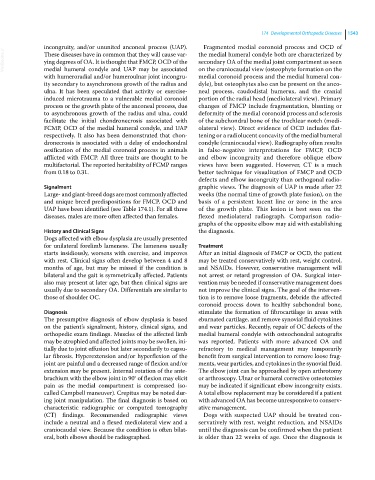Page 1605 - Clinical Small Animal Internal Medicine
P. 1605
174 Developmental Orthopedic Diseases 1543
incongruity, and/or ununited anconeal process (UAP). Fragmented medial coronoid process and OCD of
VetBooks.ir These diseases have in common that they will cause var- the medial humeral condyle both are characterized by
secondary OA of the medial joint compartment as seen
ying degrees of OA. It is thought that FMCP, OCD of the
medial humeral condyle and UAP may be associated
medial coronoid process and the medial humeral con-
with humeroradial and/or humeroulnar joint incongru- on the craniocaudal view (osteophyte formation on the
ity secondary to asynchronous growth of the radius and dyle), but osteophytes also can be present on the anco-
ulna. It has been speculated that activity or exercise‐ neal process, caudodistal humerus, and the cranial
induced microtrauma to a vulnerable medial coronoid portion of the radial head (mediolateral view). Primary
process or the growth plate of the anconeal process, due changes of FMCP include fragmentation, blunting or
to asynchronous growth of the radius and ulna, could deformity of the medial coronoid process and sclerosis
facilitate the initial chondronecrosis associated with of the subchondral bone of the trochlear notch (medi-
FCMP, OCD of the medial humeral condyle, and UAP olateral view). Direct evidence of OCD includes flat-
respectively. It also has been demonstrated that chon- tening or a radiolucent concavity of the medial humeral
dronecrosis is associated with a delay of endochondral condyle (craniocaudal view). Radiography often results
ossification of the medial coronoid process in animals in false‐negative interpretations for FMCP, OCD
afflicted with FMCP. All three traits are thought to be and elbow incongruity and therefore oblique elbow
multifactorial. The reported heritability of FCMP ranges views have been suggested. However, CT is a much
from 0.18 to 0.31. better technique for visualization of FMCP and OCD
defects and elbow incongruity than orthogonal radio-
Signalment graphic views. The diagnosis of UAP is made after 22
Large‐ and giant‐breed dogs are most commonly affected weeks (the normal time of growth plate fusion), on the
and unique breed predispositions for FMCP, OCD and basis of a persistent lucent line or zone in the area
UAP have been identified (see Table 174.1). For all three of the growth plate. This lesion is best seen on the
diseases, males are more often affected than females. flexed mediolateral radiograph. Comparison radio-
graphs of the opposite elbow may aid with establishing
History and Clinical Signs the diagnosis.
Dogs affected with elbow dysplasia are usually presented
for unilateral forelimb lameness. The lameness usually Treatment
starts insidiously, worsens with exercise, and improves After an initial diagnosis of FMCP or OCD, the patient
with rest. Clinical signs often develop between 4 and 8 may be treated conservatively with rest, weight control,
months of age, but may be missed if the condition is and NSAIDs. However, conservative management will
bilateral and the gait is symmetrically affected. Patients not arrest or retard progression of OA. Surgical inter-
also may present at later age, but then clinical signs are vention may be needed if conservative management does
usually due to secondary OA. Differentials are similar to not improve the clinical signs. The goal of the interven-
those of shoulder OC. tion is to remove loose fragments, debride the affected
coronoid process down to healthy subchondral bone,
Diagnosis stimulate the formation of fibrocartilage in areas with
The presumptive diagnosis of elbow dysplasia is based eburnated cartilage, and remove synovial fluid cytokines
on the patient’s signalment, history, clinical signs, and and wear particles. Recently, repair of OC defects of the
orthopedic exam findings. Muscles of the affected limb medial humeral condyle with osteochondral autografts
may be atrophied and affected joints may be swollen, ini- was reported. Patients with more advanced OA and
tially due to joint effusion but later secondarily to capsu- refractory to medical management may temporarily
lar fibrosis. Hyperextension and/or hyperflexion of the benefit from surgical intervention to remove loose frag-
joint are painful and a decreased range of flexion and/or ments, wear particles, and cytokines in the synovial fluid.
extension may be present. Internal rotation of the ante- The elbow joint can be approached by open arthrotomy
brachium with the elbow joint in 90° of flexion may elicit or arthroscopy. Ulnar or humeral corrective osteotomies
pain as the medial compartment is compressed (so‐ may be indicated if significant elbow incongruity exists.
called Campbell maneuver). Crepitus may be noted dur- A total elbow replacement may be considered if a patient
ing joint manipulation. The final diagnosis is based on with advanced OA has become unresponsive to conserv-
characteristic radiographic or computed tomography ative management.
(CT) findings. Recommended radiographic views Dogs with suspected UAP should be treated con-
include a neutral and a flexed mediolateral view and a servatively with rest, weight reduction, and NSAIDs
craniocaudal view. Because the condition is often bilat- until the diagnosis can be confirmed when the patient
eral, both elbows should be radiographed. is older than 22 weeks of age. Once the diagnosis is

